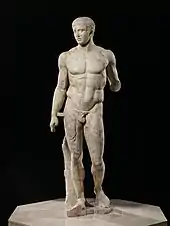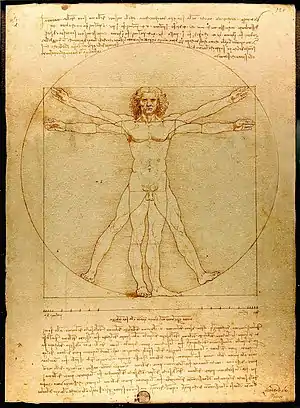Artistic canons of body proportions
An artistic canon of body proportions (or aesthetic canon of proportion), in the sphere of visual arts, is a formally codified set of criteria deemed mandatory for a particular artistic style of figurative art. The word 'canon' (from Ancient Greek: κανών, a measuring rod or standard) was first used for this type of rule in Classical Greece, where it set a reference standard for body proportions, so as to produce a harmoniously formed figure appropriate to depict gods or kings. Other art styles have similar rules that apply particularly to the representation of royal or divine personalities.
Ancient Egypt
Danish Egyptologist Erik Iverson determined the Canon of Proportions in classical Egyptian painting.[1] This work was based on still-detectable grid lines on tomb paintings: he determined that the grid was 18 cells high, with the base-line at the soles of the feet and the top of the grid aligned with hair line,[2] and the navel at the eleventh line.[3] Ivarson attempted to find a fixed (rather than relative) size for the grid, but this aspect of his work has been dismissed by later analysts.[4][5] These 'cells' were specified according to the size of the subject's fist, measured across the knuckles.[6] This proportion was already established by the Narmer Palette from about the 31st century BCE, and remained in use until at least the conquest by Alexander the Great some 3,000 years later.[6]
The Egyptian canon for painting specified for many centuries that heads should be shown in profile, that shoulders and chest be shown head-on, that hips and legs be again in profile, and that male figures should have one foot forward and female figures stand with feet together.
Classical Greece

Canon of Polykleitos
In Classical Greece, the sculptor Polykleitos (fifth centuy BCE) established the Canon of Polykleitos. Though his theoretical treatise is lost to history,[7] he is quoted as saying, "Perfection ... comes about little by little (para mikron) through many numbers".[8] By this he meant that a statue should be composed of clearly definable parts, all related to one another through a system of ideal mathematical proportions and balance. Though the Kanon was probably represented by his Doryphoros, the original bronze statue has not survived, but later marble copies exist.
Despite the many advances made by modern scholars towards a clearer comprehension of the theoretical basis of the Canon of Polykleitos, the results of these studies show an absence of any general agreement upon the practical application of that canon in works of art. An observation on the subject by Rhys Carpenter remains valid:[9] "Yet it must rank as one of the curiosities of our archaeological scholarship that no-one has thus far succeeded in extracting the recipe of the written canon from its visible embodiment, and compiling the commensurable numbers that we know it incorporates."[lower-alpha 1]
— Richard Tobin, The Canon of Polykleitos, 1975.[10]
Canon of Lysippos
The sculptor Lysippos (fourth century BCE) developed a more gracile style.[11] In his Historia Naturalis, Pliny the elder wrote that Lysippos introduced a new canon into art: capita minora faciendo quam antiqui, corpora graciliora siccioraque, per qum proceritassignorum major videretur,[12][lower-alpha 2] signifying "a canon of bodily proportions essentially different from that of Polykleitos".[14] Lysippos is credited with having established the 'eight heads high' canon of proportion.[15]
Classical India
The artist does not choose his own problems: he finds in the canon instruction to make such and such images in such and such [a] fashion - for example, an image of Nataraja with four arms, of Brahma with four heads, of Mahisha-Mardini with ten arms, or Ganesa with an elephant’s head.[16]
It is in drawing from the life that a canon is likely to be a hindrance to the artist; but it is not the method of Indian art to work from the model. Almost the whole philosophy of Indian art is summed up in the verse of Śukrācārya's Śukranĩtisāra which enjoins meditations upon the imager: "In order that the form of an image may be brought fully and clearly before the mind, the imager should medi[t]ate; and his success will be proportionate to his meditation. No other way—not indeed seeing the object itself—will achieve his purpose." The canon then, is of use as a rule of thumb, relieving him of some part of the technical difficulties, leaving him free to concentrate his thought more singly on the message or burden of his work. It is only in this way that it must have been used in periods of great achievement, or by great artists.[17]
— Ananda K. Coomaraswamy
Japan in the Heian period
Canon of Jōchō
Jōchō (定朝; died 1057 CE), also known as Jōchō Busshi, was a Japanese sculptor of the Heian period. He popularised the yosegi technique of sculpting a single figure out of many pieces of wood, and he redefined the canon of body proportions used in Japan to create Buddhist imagery.[18] He based the measurements on a unit equal to the distance between the sculpted figure's chin and hairline.[19] The distance between each knee (in the seated lotus pose) is equal to the distance from the bottoms of the legs to the hair.[19]
Renaissance Italy

Other such systems of 'ideal proportions' in painting and sculpture include Leonardo da Vinci's Vitruvian Man, based on a record of body proportions made by the architect Vitruvius,[20] in the third book of his series De architectura. Rather than setting a canon of ideal body proportions for others to follow, Vitruvius sought to identify the proportions that exist in reality; da Vinci idealised these proportions in the commentary that accompanies his drawing:
The length of the outspread arms is equal to the height of a man; from the hairline to the bottom of the chin is one-tenth of the height of a man; from below the chin to the top of the head is one-eighth of the height of a man; from above the chest to the top of the head is one-sixth of the height of a man; from above the chest to the hairline is one-seventh of the height of a man. The maximum width of the shoulders is a quarter of the height of a man; from the breasts to the top of the head is a quarter of the height of a man; the distance from the elbow to the tip of the hand is a quarter of the height of a man; the distance from the elbow to the armpit is one-eighth of the height of a man; the length of the hand is one-tenth of the height of a man; the root of the penis is at half the height of a man; the foot is one-seventh of the height of a man; from below the foot to below the knee is a quarter of the height of a man; from below the knee to the root of the penis is a quarter of the height of a man; the distances from below the chin to the nose and the eyebrows and the hairline are equal to the ears and to one-third of the face.[21][lower-alpha 3]
See also
- Academic art
- Beauty
- Canon (basic principle), a rule or a body of rules or principles generally established as valid and fundamental in a field of art or philosophy
- Nudity
- Neoclassicism
- Physical attractiveness
Notes
- Tobin's conjectured reconstruction is described at Polykleitos#Conjectured reconstruction.
- 'he made the heads of his statues smaller than the ancients, and defined the hair especially, making the bodies more slender and sinewy by which the height of the figure seemed greater'[13]
- Translation by Wikipedia editor, copied from Vetruvian Man
References
- Erik Iverson (1975). Canon and proportions in Egyptian art (2nd ed.). Warminster: Aris and Phillips.
- "Canon of Proportions". Pyramidofman.com.
- "The Pyramid and the body". Pyramidofman.com.
- Gay Robins (2010). Proportion and Style in Ancient Egyptian Art. University of Texas Press. ISBN 9780292787742.
- John A.R. Legon. "The Cubit and the Egyptian Canon of Art". legon.demon.co.uk.
- Smith, W. Stevenson; Simpson, William Kelly (1998). The Art and Architecture of Ancient Egypt. Penguin/Yale History of Art (3rd ed.). Yale University Press. pp. 12–13, note 17. ISBN 0300077475.
- "Art: Doryphoros (Canon)". Art Through Time: A Global View. Annenberg Learner. Retrieved 15 September 2020.
we are told quite unequivocally that he related every part to every other part and to the whole and used a mathematical formula in order to do so. What that formula was is a matter of conjecture.
- Philo, Mechanicus (4.1, 49.20), quoted in Andrew Stewart (1990). "Polykleitos of Argos". One Hundred Greek Sculptors: Their Careers and Extant Works. New Haven: Yale University Press..
- Rhys Carpenter (1960). Greek Sculpture : a critical review. Chicago: University of Chicago Press. p. 100. cited in Tobin (1975)
- Tobin, Richard (1975). "The Canon of Polykleitos". American Journal of Archaeology. 79 (4): 307–321. doi:10.2307/503064. JSTOR 503064. Retrieved 2 October 2020.
- Charles Waldstein, PhD. (December 17, 1879). Praxiteles and the Hermes with the Dionysos-child from the Heraion in Olympia (PDF). p. 18.
The canon of Polykleitos was heavy and square, his statues were quadrata signa, the canon of Lysippos was more slim, less fleshy
- Pliny the Elder. "XXXIV 65". Historia Naturalis. cited in Waldstein (1879)
- George Redford, FRCS. "Lysippos and Macedonian Art". A manual of ancient sculpture: Egyptian–Assyrian–Greek–Roman (PDF). p. 193.
- Walter Woodburn Hyde (1921). Olympic Victor Monuments and Greek Athletic Art. Washington: the Carnegie Institution of Washington. p. 136.
- "Hercules: The influence of works by Lysippos". Paris: The Louvre. Retrieved 4 October 2020.
In the fourth century BCE, Lysippos drew up a canon of proportions for a more elongated figure that that defined by Polykleitos in the previous century. According to Lysippos, the height of the head should be one-eighth the height of the body, and not one-seventh, as Polykleitos recommended.
- Ananda K. Coomaraswamy (1911). "Indian Images with Many Arms". The Dance of Shiva – fourteen Indian essays.
- Ananda Coomaraswamy (1934). "Aesthetic of The Śukranĩtisāra". The Transformation of Nature in Art. Cambridge, Mass.: Harvard University Press. pp. 111–117. cited in Mosteller, John F (1988). "The Study of Indian Iconometry in Historical Perspective". Journal of the American Oriental Society. 108 (1): 99–110. doi:10.2307/603249. JSTOR 603249. Retrieved 7 October 2020.
- Miyeko Murase (1975). Japanese art : selections from the Mary and Jackson Burke Collection. New York, N.Y.: Metropolitan Museum of Art. p. 22. ISBN 9780870991363.
- Mason, Penelope; Dinwiddie, Donald (2005). History of Japanese Art (2nd. ed.). Upper Saddle River, New Jersey: Pearson Prentice Hall. p. 144. ISBN 9780131176010.
- Vitruvius. "I, "On Symmetry: In Temples And In The Human Body"". Ten Books on Architecture, Book III. Translated by Morris Hicky Morgan. Harvard University Press. Retrieved 15 October 2020 – via Gutenberg.org.
- Leonardo da Vinci. "Human proportions". The Notebooks of Leonardo da Vinci. Translated by Edward MacCurdy. Raynal and Hitchcock Inc. p. 213–214 – via Archive.org.